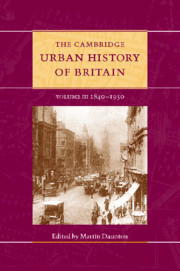Book contents
- Frontmatter
- 1 Introduction
- Part I Circulation
- 2 Urban networks
- 3 Modern London
- 4 Ports
- 5 The development of small towns in Britain
- 6 Migration
- 7 Pollution in the city
- 8 From Shillibeer to Buchanan: transport and the urban environment
- Part II Governance
- Part III Construction
- Part IV Getting and spending
- Part V Images
- Select bibliography
- Index
- Plates 1-7
- Plates 8-14
- Plates 15-20
- Plates 21-27
- Plates 28-34
- Plates 35-41
- Plates 42-48>
- Plates 49-53
- References
4 - Ports
from Part I - Circulation
Published online by Cambridge University Press: 28 March 2008
- Frontmatter
- 1 Introduction
- Part I Circulation
- 2 Urban networks
- 3 Modern London
- 4 Ports
- 5 The development of small towns in Britain
- 6 Migration
- 7 Pollution in the city
- 8 From Shillibeer to Buchanan: transport and the urban environment
- Part II Governance
- Part III Construction
- Part IV Getting and spending
- Part V Images
- Select bibliography
- Index
- Plates 1-7
- Plates 8-14
- Plates 15-20
- Plates 21-27
- Plates 28-34
- Plates 35-41
- Plates 42-48>
- Plates 49-53
- References
Summary
While the history and the functioning of ports has attracted considerable attention from geographers, economic historians and sociologists, the area of interest has tended either to focus very narrowly on the immediate connections between land and water, such as facilities for shipping or waterfront working conditions, or to be concerned with broad perspectives, such as the value of trade and competitive position. There has been, metaphorically speaking, an inclination to look out to sea rather than inland, or to allow the dock wall to define the limits of investigation. As a result, with the exception of Martin Daunton’s study of Cardiff, ports have rarely been treated as urban entities.
This is not to say that the connection between water-based activity on a shoreline or river bank and the growth of permanent settlement has not been a very familiar and well-worked theme. But not every landing place for cargo became a town, still less a city. In 1870 the official returns identify 110 foreign trade ports in the UK. A hundred years later the oil terminals of Milford Haven, Sullom Vo and Orkney ranked high among British ports; reminders that the nature of trade and the state of cargo-handling technology are factors linking, or separating, transhipment needs and populations. Furthermore, for anyone studying ports in a maturing industrialised economy, the enhanced ability to shape the built environment (to dredge, to put up barriers against the sea, readily to take goods into the interior) necessarily shifts the analysis away from a concentration on natural features towards recognition of the human contribution; ‘in the beginning the harbour made the trade; but soon the trade began to make the harbour’.
Keywords
- Type
- Chapter
- Information
- The Cambridge Urban History of Britain , pp. 133 - 150Publisher: Cambridge University PressPrint publication year: 2001

